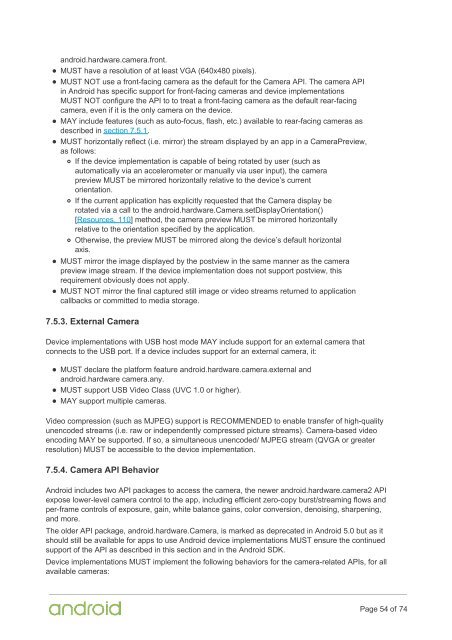Compatibility Definition
2f44OdUf0
2f44OdUf0
You also want an ePaper? Increase the reach of your titles
YUMPU automatically turns print PDFs into web optimized ePapers that Google loves.
android.hardware.camera.front.<br />
MUST have a resolution of at least VGA (640x480 pixels).<br />
MUST NOT use a front-facing camera as the default for the Camera API. The camera API<br />
in Android has specific support for front-facing cameras and device implementations<br />
MUST NOT configure the API to to treat a front-facing camera as the default rear-facing<br />
camera, even if it is the only camera on the device.<br />
MAY include features (such as auto-focus, flash, etc.) available to rear-facing cameras as<br />
described in section 7.5.1.<br />
MUST horizontally reflect (i.e. mirror) the stream displayed by an app in a CameraPreview,<br />
as follows:<br />
If the device implementation is capable of being rotated by user (such as<br />
automatically via an accelerometer or manually via user input), the camera<br />
preview MUST be mirrored horizontally relative to the device’s current<br />
orientation.<br />
If the current application has explicitly requested that the Camera display be<br />
rotated via a call to the android.hardware.Camera.setDisplayOrientation()<br />
[Resources, 110] method, the camera preview MUST be mirrored horizontally<br />
relative to the orientation specified by the application.<br />
Otherwise, the preview MUST be mirrored along the device’s default horizontal<br />
axis.<br />
MUST mirror the image displayed by the postview in the same manner as the camera<br />
preview image stream. If the device implementation does not support postview, this<br />
requirement obviously does not apply.<br />
MUST NOT mirror the final captured still image or video streams returned to application<br />
callbacks or committed to media storage.<br />
7.5.3. External Camera<br />
Device implementations with USB host mode MAY include support for an external camera that<br />
connects to the USB port. If a device includes support for an external camera, it:<br />
MUST declare the platform feature android.hardware.camera.external and<br />
android.hardware camera.any.<br />
MUST support USB Video Class (UVC 1.0 or higher).<br />
MAY support multiple cameras.<br />
Video compression (such as MJPEG) support is RECOMMENDED to enable transfer of high-quality<br />
unencoded streams (i.e. raw or independently compressed picture streams). Camera-based video<br />
encoding MAY be supported. If so, a simultaneous unencoded/ MJPEG stream (QVGA or greater<br />
resolution) MUST be accessible to the device implementation.<br />
7.5.4. Camera API Behavior<br />
Android includes two API packages to access the camera, the newer android.hardware.camera2 API<br />
expose lower-level camera control to the app, including efficient zero-copy burst/streaming flows and<br />
per-frame controls of exposure, gain, white balance gains, color conversion, denoising, sharpening,<br />
and more.<br />
The older API package, android.hardware.Camera, is marked as deprecated in Android 5.0 but as it<br />
should still be available for apps to use Android device implementations MUST ensure the continued<br />
support of the API as described in this section and in the Android SDK.<br />
Device implementations MUST implement the following behaviors for the camera-related APIs, for all<br />
available cameras:<br />
Page 54 of 74


